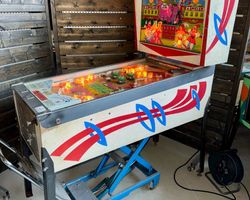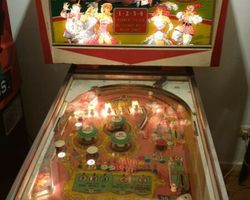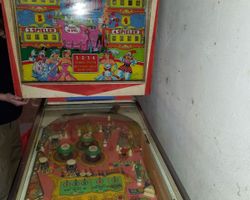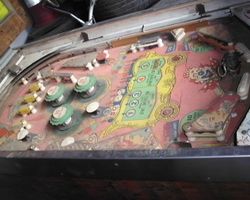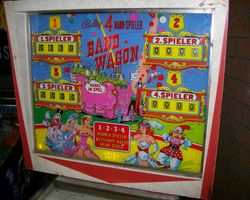Band Wagon
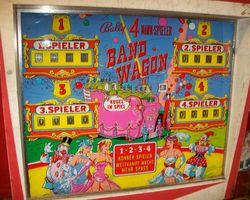
Average Prices: USD $300 to $900
Produced: March, 1965
Production Run: 1,840 units
Machine Type: Electro-mechanical
Players: 4
Design by: Ted Zale
"Band Wagon," a pinball machine manufactured by Bally Manufacturing Co. and released in March 1965, stands as a notable electro-mechanical (EM) era creation. With a production run of 1,840 units, this four-player game embraced a vibrant carnival and circus theme, immediately setting a lively backdrop for its playfield. The machine's design and conceptualization were primarily attributed to Ted Zale, who also handled the animation and mechanics. Zale's comprehensive involvement in "Band Wagon" underscores his significant influence on its unique character and gameplay. The era of its release, the mid-1960s, was a period of innovation in pinball, where designers pushed the boundaries of mechanical possibility to create engaging and challenging experiences. An interesting detail in its production history is the existence of a German version, indicating Bally's reach into international markets even at this early stage of modern pinball.
Signature Features and Design
"Band Wagon" immediately distinguishes itself through its innovative design, largely credited to Ted Zale's forward-thinking approach. The playfield is defined by a "fantastic asymmetrical layout," a signature element that deviates from the more common symmetrical designs of its time. This deliberate imbalance was not merely an aesthetic choice; it fundamentally shaped the gameplay flow, guiding the player's eye and the ball's trajectory in a dynamic, non-linear fashion. The machine features two flippers, positioned strategically to interact with three pop bumpers and four mushroom bumpers, along with three slingshots that add unpredictability to ball movement.
Beyond these core components, "Band Wagon" incorporates several unique mechanical elements that enhance its appeal. An upper right ball return gate and a right outlane ball return gate provide opportunities for skill shots and risk-reward decisions, influencing ball preservation. The visual appeal is heightened by "wonderful colors and artwork" that vividly depict the carnival theme, transforming the playfield into a bustling circus tent filled with whimsical characters and attractions. The game communicates scores via mechanical reels, capable of displaying up to 9,999 points per player. Its auditory feedback is provided by two bells and a knocker, generating the distinctive electro-mechanical symphony characteristic of the era.
Playfield and Mechanics
The heart of "Band Wagon" lies in its meticulously crafted playfield, an exemplar of Ted Zale's unconventional design philosophy. The asymmetrical layout is not just visually striking; it dictates a specific, engaging flow that encourages players to interact with every quadrant of the game. Central to the gameplay is a progressive series of shots, designated by numbers 1 through 5, strategically positioned to take the player around the entire playfield. Players are challenged to hit shots 1-2-3, typically positioned lower or mid-playfield, before progressing to shots 4 and then 5, which are often in more challenging upper areas. This sequential objective provides a clear sense of progression and mastery.
The playfield is populated with various targets and features crucial for advancing through this numbered sequence. Three rollover buttons provide points and potentially light specific features, while the array of pop bumpers and mushroom bumpers creates chaotic yet rewarding carom shots. A particularly demanding element is an alternating lit lane located at the top of the playfield. Successfully hitting this lane often requires precise flipper control combined with skillful nudging of the machine, adding a layer of physical interaction beyond simple flipper presses. The overall aesthetic of the playfield, with its bright, inviting colors and detailed carnival artwork, complements the mechanical elements, drawing players into the festive atmosphere. The lighting design subtly highlights active targets and scoring opportunities, guiding the player's focus without detracting from the overall visual experience.
Gameplay Dynamics
"Band Wagon"'s gameplay dynamics revolve around its core objective: successfully completing the sequential shot progression from 1 to 5. This seemingly straightforward task becomes a test of precision and control due to the machine's inherent characteristics. Each numbered shot, once made, often lights up the next in the sequence, guiding the player through the intended flow. Points are accumulated through hitting various targets, bumpers, and completing the numbered shots, with the mechanical reels tracking scores up to 9,999 for each of the four players.
A significant aspect of "Band Wagon"'s gameplay, and a frequent topic of discussion among enthusiasts, is the performance of its flippers. Often described as "flacco-master flippers," their strength and responsiveness are critical. If the machine is not properly adjusted and maintained, these flippers can make it exceedingly difficult, if not impossible, to achieve the necessary power and accuracy to hit the upper loops and complete the higher-numbered shots. However, when the flippers are correctly calibrated and functioning optimally, the game transforms into a demanding yet rewarding experience that challenges players to master their shots.
Beyond the sequential shots, players can aim for general scoring through the extensive array of pop and mushroom bumpers. The three slingshots introduce dynamic rebounds, forcing players to react quickly and adapt to unpredictable ball trajectories. The alternating lit lane at the top of the playfield presents a skill shot that offers significant points or advances features, requiring precise timing or calculated nudges to guide the ball into the correct opening. "Band Wagon" supports 3 or 5-ball play, allowing operators to adjust the game's duration and challenge. A distinctive element of its design is the tilt penalty: a tilt results in "game over" for the tilting player, a strict consequence that demands careful physical interaction with the machine. This rule, combined with the often-challenging flippers, makes "Band Wagon" a game that rewards patience and a refined playing style.
Reception and Legacy
"Band Wagon" holds a positive standing within the pinball community, largely attributed to Ted Zale's innovative design sensibilities. Its reception has consistently highlighted Zale's "ahead of its time" approach, particularly concerning the asymmetrical playfield layout. Enthusiasts praise how this design intelligently guides the player through the entire game area, offering a distinct departure from more conventional layouts. The game's vibrant colors and engaging carnival artwork are frequently cited as "wonderful," contributing significantly to its appeal and overall thematic immersion. Many consider "Band Wagon" a genuinely "fun to play" and "great game" that provides an enjoyable experience, especially for an electro-mechanical machine from 1965. Its ability to support four players also contributes to its positive reception, making it suitable for competitive play.
Despite its many strengths, "Band Wagon" does present certain challenges that have been noted by players. The primary point of contention often revolves around the flipper strength. If not meticulously adjusted, the "flacco-master flippers" can indeed render certain shots, particularly those aiming for the upper loops, unplayable. This necessitates proper maintenance and setup to ensure the machine plays as intended. Opinions on the machine's sound package are mixed; while some appreciate the classic electro-mechanical sounds, others have described the bells as "tinny," indicating a subjective preference regarding audio quality. Another specific detail that sometimes generates discussion is the tilt mechanism, which results in "game over" for the individual player who tilts, a strict penalty for a multi-player game.
Regardless of these points, "Band Wagon"'s legacy endures as a testament to Ted Zale's design prowess. It is regarded as an example of intelligent playfield design from the EM era, influencing how designers considered flow and player progression in subsequent machines. Its reputation as a "player" is solidified when the machine is in good working order, offering a challenging yet deeply satisfying experience that encourages repeat play. "Band Wagon" remains a cherished example of mid-1960s pinball, celebrated for its unique layout and its ability to engage players through a blend of strategic shots and demanding mechanical interaction.
Sponsored Links
 Ebay Listings
Ebay Listings
 Auction Results
Auction Results
| Cost | Location | Date |
|---|---|---|
| EUR €900 |  Nordrhein-Westfalen, Germany Nordrhein-Westfalen, Germany |
17 May, 2025 |
| USD $600 |  Texas, United States Texas, United States |
16 November, 2021 |
| EUR €999 |  Hessen, Germany Hessen, Germany |
11 January, 2021 |
| EUR €955 |  Hessen, Germany Hessen, Germany |
08 January, 2021 |
| EUR €224 |  Schlewig-Holstein, Germany Schlewig-Holstein, Germany |
21 September, 2020 |
| AUD $400 |  Queensland, Australia Queensland, Australia |
28 November, 2019 |
| EUR €356 |  Baden-Württemberg, Germany Baden-Württemberg, Germany |
03 December, 2017 |
| AUD $550 |  Queensland, Australia Queensland, Australia |
09 May, 2017 |
| EUR €173 |  Austria Austria |
06 May, 2016 |
| EUR €257 |  Bayern, Germany Bayern, Germany |
08 November, 2014 |


Private Policy · Search Website · Contact Us
As an eBay Partner, we may earn a commission from qualifying purchases made through links on this site, at no additional cost to you.
All trademarks and copyrighted materials remain property of their respective owners. All other content copyright 2007 - 2026 Pinpedia.

